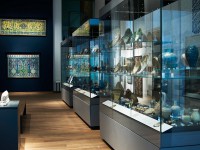Room 31 | Islamic Middle East gallery
Explore artefacts made over a period of more than 1000 years in the heart of the Islamic world.

Galleries : 14 objects
Show search help- Reference URL
Actions
Bowl with vegetal and epigraphic decoration
-
Description
The significance of medieval ceramic production in Syria is not yet fully understood. The production of lustrewares, however, is amongst the most widely documented in the region, and the decorative glaze effects display a distinctive style when compared to Egypt or Syria. This bowl’s decoration of a single, central epigraphic motif, placed against rich foliage is found in several examples attributed to the two most prominent Syrian centres, Raqqa and Tell Minis.
-
Details
- Associated place
- Date
- 1st half of the 13th century
- Material and technique
- fritware, with overglaze painting in lustre
- Dimensions
-
10.9 cm (height)
22 cm (diameter)
at foot 7.5 cm (diameter)
- Material index
- Technique index
- Object type index
- No. of items
- 1
- Credit line
- Gift of Gerald Reitlinger, 1978.
- Accession no.
- EA1978.2175
-
Further reading
Allan, James W., Islamic Ceramics, Ashmolean-Christie's Handbooks (Oxford: Ashmolean Museum, 1991), no. 23 on p. 40, illus. p. 41
Porter, Venetia, Medieval Syrian Pottery (Raqqa Ware) (Oxford: Asmolean Museum, 1981), illus. p. 27 pl. XVIII
London: Hayward Gallery, 8 April-4 July 1976, The Arts of Islam, Dalu Jones and George Michell, eds (London: Arts Council of Great Britian, 1976), no. 304 on p. 230
Glossary (3)
fritware, glaze, lustre
-
fritware
Ceramic material composed of ground quartz and small quantities of clay and finely ground frit (frit is obtained by pouring molten glass into water).
-
glaze
Vitreous coating applied to the surface of a ceramic to make it impermeable or for decorative effect.
-
lustre
Metallic sheen obtained by applying a mixture of metallic oxides onto an already glazed ceramic that is refired at a reduced atmosphere.
Location
Objects are sometimes moved to a different location. Our object location data is usually updated on a monthly basis. Contact the Jameel Study Centre if you are planning to visit the museum to see a particular object on display, or would like to arrange an appointment to see an object in our reserve collections.
Collection trails
Galleries
Publications online
-

Islamic Ceramics
The precise origins of the medieval Syrian lustre industry are uncertain, though it probably derives from the Fatimid Egyptian tradition. One school, associated with Tell Minis in northern Syria, is often characterised by figural designs; that associated with the city of Raqqa on the Euphrates, of which the two opposite are examples, tends towards vegetal patterns or calligraphy. In the latter case the lustre is often rather chocolate in tone. On these two bowls, the artists (or perhaps artist?) have taken the Arabic word al-surr, ‘happiness’ and, combining brush strokes and imagination, have created two very similar, bold designs, each of which strongly suggests a peacock. The contrast between the two is quite marked, however, the one [EA1978.2175] being tightly controlled and static in impact, the other [EAX.3068] far more fluid and fluent, almost with a life of its own.
Notice
Objects may have since been removed or replaced from a gallery. Click into an individual object record to confirm whether or not an object is currently on display. Our object location data is usually updated on a monthly basis, so contact the Jameel Study Centre if you are planning to visit the museum to see a particular Eastern Art object.
© 2013 University of Oxford - Ashmolean Museum













